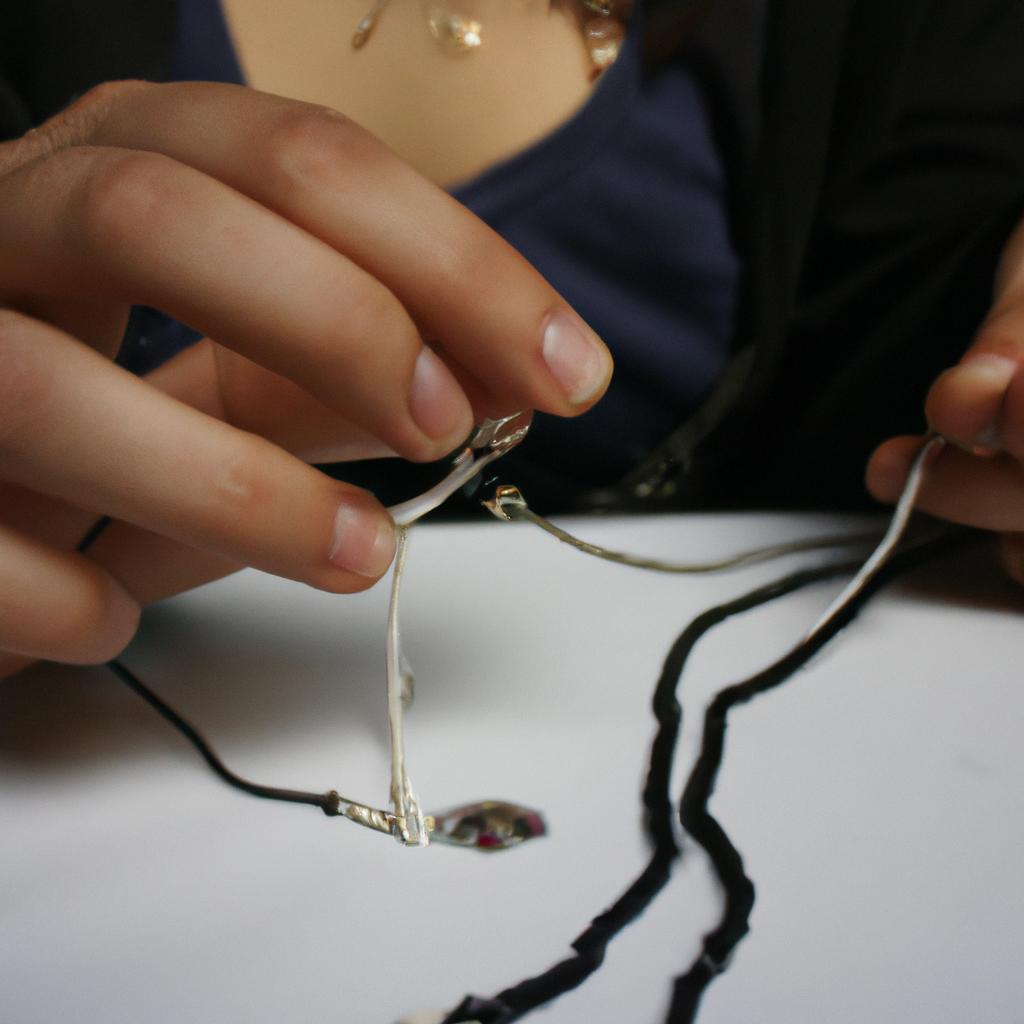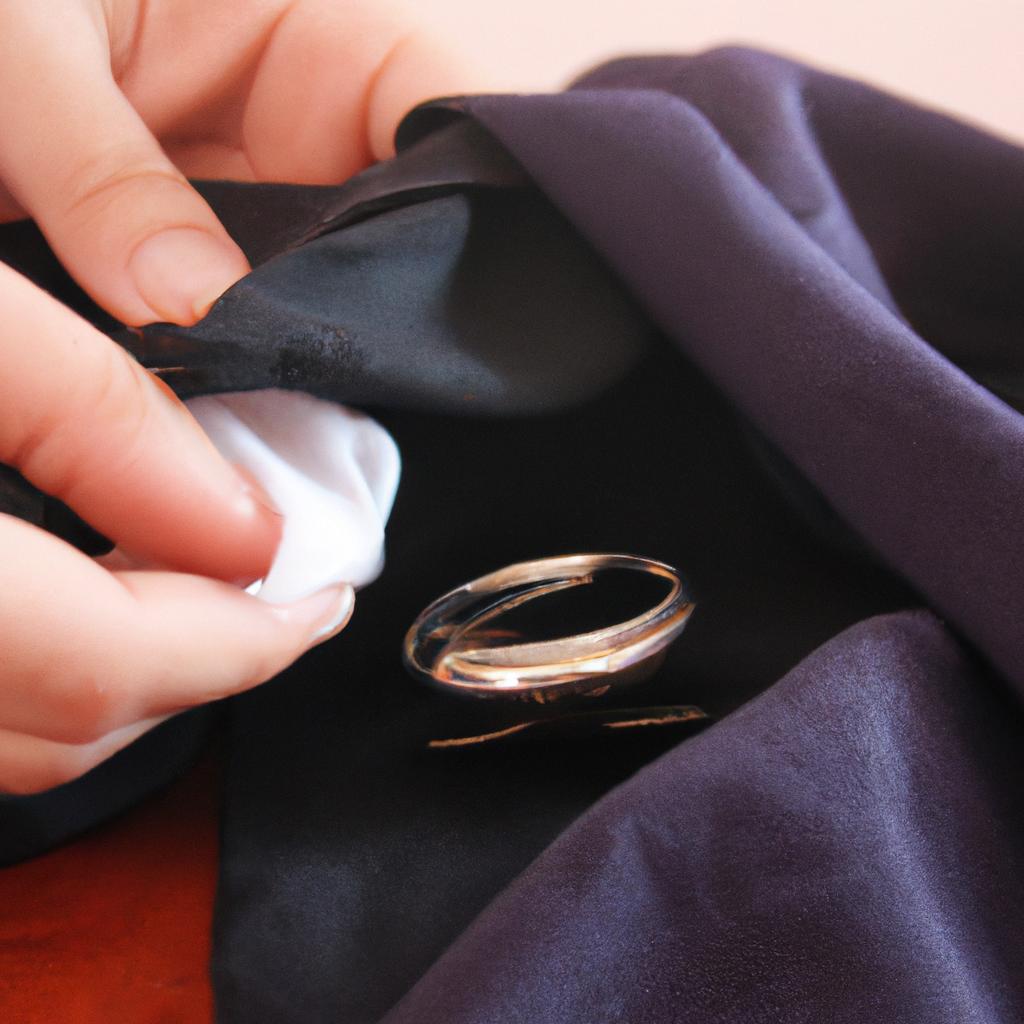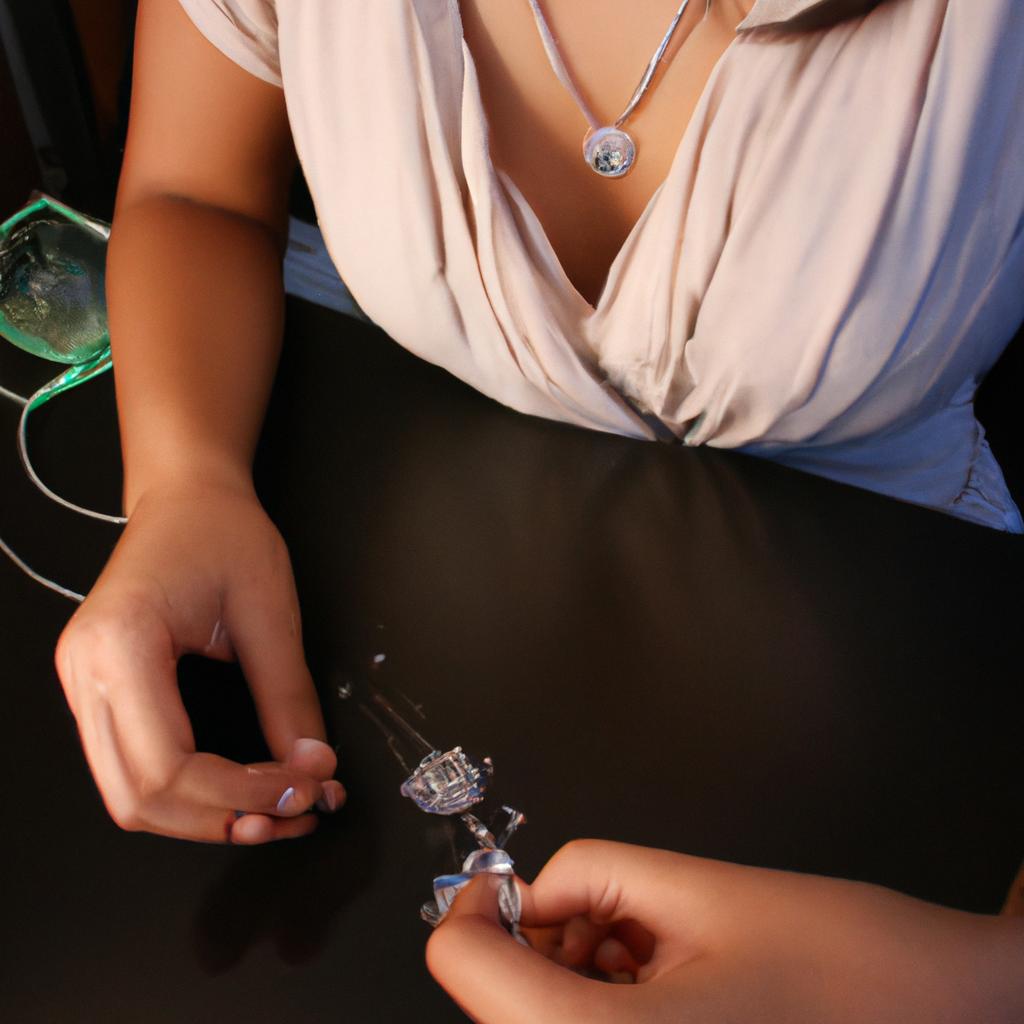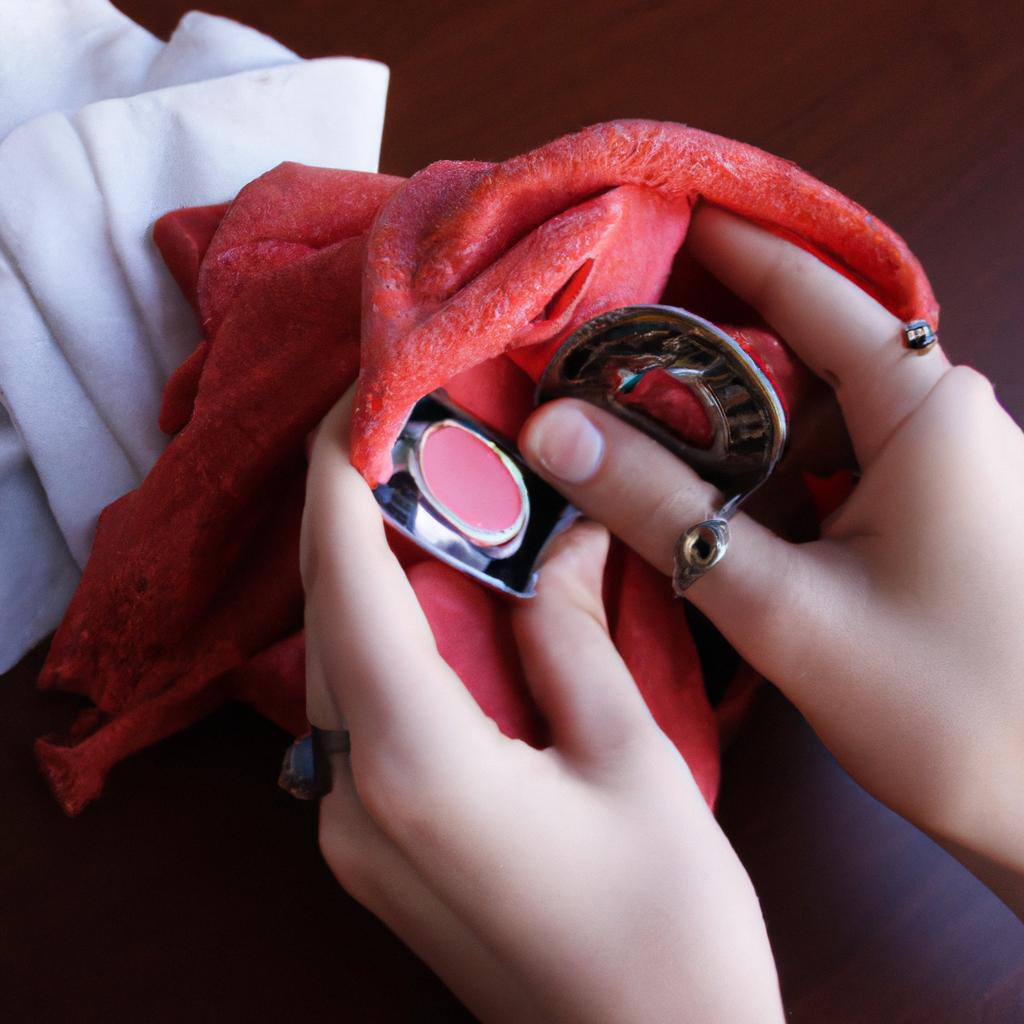Jewelry holds a special place in our lives, serving as not only an expression of personal style but also as cherished heirlooms and symbols of significant milestones. However, over time, jewelry can lose its luster due to dirt, oils, and other environmental factors. Proper cleaning methods are essential for maintaining the beauty and longevity of these precious pieces. For instance, imagine a scenario where a beloved family heirloom diamond necklace loses its sparkle. Without proper knowledge of cleaning methods, one may inadvertently damage or devalue this treasured item. In order to preserve the aesthetic appeal and monetary value of jewelry, it is crucial to adopt appropriate cleaning techniques that cater to different types of metals, gemstones, and settings.
This comprehensive guide aims to provide readers with valuable insights into various cleaning methods for jewelry maintenance. Drawing upon extensive research from reputable sources within the field of jewelry care, this article will present an overview of effective techniques specifically designed for different materials commonly found in jewelry such as gold, silver, platinum, diamonds, pearls, and gemstones. Additionally, it will explore how to identify signs of damage or wear-and-tear that necessitate professional intervention rather than at-home remedies. By equipping oneself with the necessary knowledge outlined in this guide, individuals can confidently and effectively clean their jewelry, ensuring its longevity and preserving its beauty for years to come.
One of the first steps in cleaning jewelry is determining the type of metal it is made from. Different metals require specific cleaning methods to avoid damage. For example, gold jewelry can be cleaned using a mild soap and warm water solution, gently scrubbing with a soft brush or cloth. Silver jewelry, on the other hand, may tarnish over time and requires regular polishing with a silver-specific cleaner or a homemade solution consisting of baking soda and water.
Platinum jewelry is known for its durability but still requires proper care. A mixture of mild dish soap and warm water can be used to clean platinum pieces, followed by gentle brushing with a soft toothbrush. It’s important to note that certain gemstones set in platinum may require extra caution when cleaning to prevent any potential damage.
Diamonds are one of the hardest substances on Earth, making them relatively easy to clean. Soak diamond jewelry in a mixture of mild detergent and warm water before gently brushing with a soft toothbrush. Be sure to rinse thoroughly and dry with a lint-free cloth.
Pearls are delicate gems that require special care. They should be wiped gently with a soft cloth after each use to remove oils and dirt. Avoid exposing pearls to harsh chemicals or ultrasonic cleaners as they can damage the luster and structure of the pearls.
Gemstones come in various types such as emeralds, rubies, sapphires, and more. Each gemstone has different characteristics that determine how they should be cleaned. Some gemstones can tolerate mild soap and water solutions, while others may require professional cleaning due to their sensitivity.
While regular cleaning is essential for maintaining the appearance of your jewelry, it’s equally important to keep an eye out for signs of damage or wear-and-tear that may require professional intervention. These signs include loose stones, worn prongs or settings, and scratches on the metal surface. In such cases, it is best to consult a professional jeweler who can assess the damage and provide appropriate repairs.
In conclusion, proper cleaning methods are vital for preserving the beauty and longevity of jewelry. By understanding the specific cleaning requirements for different metals, gemstones, and settings, individuals can confidently care for their precious pieces. Regular maintenance combined with professional intervention when necessary will help ensure that jewelry continues to shine bright as cherished heirlooms and symbols of significant milestones.
Types of Jewelry Cleaning Solutions
Imagine you have just received a beautiful diamond ring as a gift from a loved one. Over time, however, the ring starts to lose its sparkle and shine due to accumulated dirt and oils. To restore its brilliance, it is essential to understand the different types of cleaning solutions available for jewelry.
One example of an effective jewelry cleaning solution is the traditional method of using warm soapy water. By mixing mild dish soap with warm water, you can create a gentle yet efficient solution that removes dirt and grime without causing any damage. This method is particularly suitable for everyday jewelry pieces such as silver earrings or delicate gemstone necklaces.
- Commercial Jewelry Cleaners: These are specially formulated products designed for specific types of jewelry materials like gold, silver, or pearls.
- Ultrasonic Cleaners: Utilizing high-frequency sound waves, these machines generate tiny bubbles that gently remove dirt particles from hard-to-reach areas.
- Homemade Solutions: Natural ingredients such as vinegar, baking soda, or lemon juice can be combined to create cost-effective cleaning mixtures that are eco-friendly.
In addition to the bullet points mentioned above, we can also illustrate the differences between these cleaning solutions in table format:
| Type of Solution | Characteristics |
|---|---|
| Commercial cleaners | Tailored formulas for specific metals |
| Ultrasonic cleaners | Effective at reaching intricate areas |
| Homemade solutions | Environmentally friendly alternatives |
Understanding the pros and cons of each type empowers you to make informed decisions when choosing how best to clean your precious belongings. Now equipped with this knowledge about different cleaning methods, let us delve into the specifics of caring for gold and gold-plated jewelry – specifically targeting their unique properties and maintenance requirements.
Cleaning Gold and Gold-plated Jewelry
Imagine you have a beautiful gold necklace that has lost its luster over time. You want to restore its original shine but are unsure of the best cleaning method. In this section, we will explore effective ways to clean gold and gold-plated jewelry, ensuring they remain in pristine condition for years to come.
When it comes to cleaning gold and gold-plated jewelry, there are several methods you can try. Here are some recommended techniques:
-
Soap and Water: Begin by mixing a small amount of mild dish soap with warm water in a bowl. Place your gold or gold-plated jewelry into the mixture and let it soak for about 15-20 minutes. Gently scrub each piece using a soft-bristle brush or toothbrush. Rinse thoroughly under running water and pat dry with a soft cloth.
-
Ammonia Solution: For more stubborn tarnish or dirt, consider using an ammonia solution. Mix one part household ammonia with six parts water in a container. Submerge your jewelry in the solution for no longer than one minute before removing it and rinsing it thoroughly under running water. Dry gently with a soft cloth.
-
Commercial Jewelry Cleaners: Another option is to use commercial jewelry cleaners specifically designed for gold or gold-plated items. Follow the instructions provided on the packaging carefully, as different products may have varying application methods.
-
Ultrasonic Cleaner (Professional Cleaning): For deep-cleaning purposes, professional jewelers often utilize ultrasonic cleaners. These devices use high-frequency sound waves to remove dirt and grime from delicate pieces without causing damage.
Emphasizing the importance of properly caring for your precious possessions can evoke strong emotions among readers who cherish their own jewelry collections:
- Preserve Sentimental Value: By maintaining the appearance of your cherished heirlooms, you ensure they continue to carry sentimental value through generations.
- Boost Confidence: Wearing well-maintained jewelry can enhance one’s confidence and overall self-image, allowing them to make a stylish statement.
- Extend Lifespan: Regular cleaning prevents tarnish and corrosion, extending the lifespan of your gold or gold-plated pieces.
- Maintain Investment Value: Gold jewelry is often considered an investment. Proper care ensures that its monetary value remains intact.
| Preserve Sentimental Value | Boost Confidence | Extend Lifespan | Maintain Investment Value |
|---|---|---|---|
| Cherished heirlooms passed down through generations | Enhance self-image and style statement | Prevent tarnish and corrosion for longevity | Protect monetary worth as an investment |
In conclusion, keeping your gold and gold-plated jewelry clean is essential for maintaining their beauty and sentimental value. Whether you choose to use soap and water, ammonia solutions, commercial cleaners, or seek professional assistance with ultrasonic cleaners, regular maintenance will ensure your treasures shine brightly.
Transitioning into the subsequent section about “Cleaning Silver and Silver-plated Jewelry,” it is important to note that silver requires unique care techniques compared to gold.
Cleaning Silver and Silver-plated Jewelry
After discussing the cleaning methods for gold and gold-plated jewelry, let us now turn our attention to silver and silver-plated pieces. To illustrate the importance of proper care, consider a hypothetical scenario where an individual named Sarah inherits a beautiful vintage silver necklace from her grandmother. Over time, without regular cleaning and maintenance, Sarah notices that the necklace begins to lose its luster and tarnish starts to form on its surface. This serves as a reminder that even precious metals like silver require diligent upkeep to maintain their shine.
To ensure your silver and silver-plated jewelry remains in pristine condition, here are some key tips:
-
Regular Cleaning: Like all jewelry, regular cleaning is essential for maintaining the appearance of silver pieces. Use a soft cloth or a specially formulated jewelry cleaner specifically designed for use with silver.
-
Polishing: In addition to routine cleaning, occasional polishing can help restore the natural sheen of your silver jewelry. Utilize a non-abrasive polishing cream or polish pad made explicitly for this purpose.
-
Storage: Proper storage plays a vital role in preventing tarnishing of your silver items. Keep them away from direct sunlight or excessive heat, which can accelerate oxidation. Store each piece separately in a pouch or compartmentalized box to avoid scratching.
-
Professional Maintenance: For valuable or intricate pieces of sterling silver jewelry, seeking professional maintenance can be beneficial. Experts possess specialized knowledge and equipment necessary for deep cleaning and restoring heavily tarnished items.
Table: Common Household Products That May Damage Silver Jewelry
| Product | Effect on Silver Jewelry |
|---|---|
| Chlorine | Causes discoloration |
| Ammonia | Can lead to corrosion |
| Vinegar | Promotes tarnishing |
| Toothpaste | Abrasive nature may scratch |
By following these guidelines and avoiding common household products that can damage silver jewelry, you will be able to preserve the beauty and longevity of your cherished pieces. Now, let us delve into the fascinating realm of cleaning gemstone jewelry.
Moving from silver to gemstones, it is crucial to understand how different types of gemstones require specific care in order to maintain their brilliance.
Cleaning Gemstone Jewelry
After ensuring your silver and silver-plated jewelry is sparkling clean, let’s move on to another essential category: gemstone jewelry. Imagine you have a stunning emerald ring that has lost its luster over time. To restore its brilliance, follow these expert tips:
Firstly, assess the type of gemstone you are dealing with. Each gem requires specific care due to variations in hardness and durability. For instance, softer gems like opals and pearls require delicate handling compared to harder ones such as diamonds or sapphires.
Next, gather the necessary materials for cleaning gemstone jewelry:
- Mild dish soap
- Soft bristle toothbrush
- Lukewarm water
- Microfiber cloth
To start the cleaning process:
- Fill a small bowl with lukewarm water and add a few drops of mild dish soap.
- Place your gemstone jewelry into the soapy solution and let it soak for 10-15 minutes.
- Gently scrub each piece with a soft-bristled toothbrush to remove any dirt or grime.
- Rinse the jewelry under running lukewarm water until all traces of soap are gone.
- Pat dry using a microfiber cloth, being careful not to apply excessive pressure that may damage fragile stones.
Now that you know how to clean your precious gemstone pieces effectively, remember that regular maintenance is key to preserving their beauty for years to come. Refer back to this guide whenever needed or consider consulting a professional jeweler for specialized advice.
Transitioning smoothly into our next topic about diamond jewelry care…
Cleaning Diamond Jewelry
Consider the case of Sarah, who inherited a stunning diamond necklace from her grandmother. Over time, she noticed that the diamonds had lost their sparkle and appeared dull. This led her to seek effective methods for cleaning her precious jewelry. In this section, we will explore techniques specifically tailored for cleaning diamond jewelry.
To ensure your diamond jewelry regains its brilliance, follow these steps:
- Prepare a gentle cleaning solution by mixing warm water with a few drops of mild dish soap.
- Use a soft-bristled toothbrush or an old toothbrush dedicated solely to cleaning jewelry.
- Gently scrub the diamonds in circular motions, paying particular attention to hard-to-reach areas where dirt may accumulate.
- Rinse your diamond jewelry under running water to remove any remaining soap residue.
Now let’s delve into some common mistakes people make when attempting to clean their diamond jewelry:
| Mistakes | Consequences |
|---|---|
| Using harsh chemicals | May damage the setting or even scratch the diamonds themselves |
| Excessive scrubbing | Can loosen prongs or settings, risking potential stone loss |
| Neglecting regular maintenance | Allows dirt and grime to build up over time, diminishing the shine |
By avoiding these pitfalls and following proper cleaning procedures, you can maintain the luster and beauty of your diamond jewelry for years to come.
In our next section, we will shift our focus towards another delicate gemstone: pearls. By understanding how to properly care for pearl jewelry, you can preserve their elegance and natural radiance without causing any harm during the cleaning process
Cleaning Pearl Jewelry
Transitioning from the previous section on cleaning diamond jewelry, it is essential to note that pearls require a different approach due to their delicate nature. Let us delve into the best practices for cleaning and maintaining pearl jewelry.
Imagine you have a cherished strand of freshwater pearls that has lost its luster over time. To restore their natural radiance, follow these steps:
- Begin by preparing a solution of lukewarm water mixed with a mild soap or baby shampoo.
- Gently dip a soft cloth or sponge into the soapy mixture and wring out any excess liquid.
- Carefully wipe each individual pearl using small circular motions to remove dirt and oils accumulated from wear.
- Rinse the pearls under running water to ensure all traces of soap are removed, as residue can dull their appearance.
- Lay them flat on a clean towel and allow them to air dry completely before storing or wearing again.
To further emphasize the importance of proper care, consider the emotional value associated with your pearl jewelry:
- Pearls often symbolize purity, innocence, and elegance; taking care of them preserves not only their physical beauty but also their sentimental significance.
- By following appropriate cleaning methods, you demonstrate respect for tradition and craftsmanship while honoring the legacy passed down through generations.
- Regular maintenance prolongs the lifespan of your beloved pieces, allowing future generations to cherish them just as much as you do.
- Neglecting proper care may lead to irreversible damage or discoloration, causing distress when realizing what could have been prevented.
Additionally, we present below an overview of common dos and don’ts when handling pearl jewelry:
| Do’s | Don’ts |
|---|---|
| Store in a soft pouch or cloth | Expose pearls to harsh chemicals |
| Clean gently using mild soap | Wear during activities prone to impact |
| Remove before applying makeup | Use abrasive materials for cleaning |
| Restring regularly | Expose to extreme temperatures |
By adhering to these guidelines and adopting a cautious approach, you can ensure the longevity of your pearl jewelry collection. Treat each piece with care, appreciating its unique beauty and significance it holds in your life.
In conclusion, caring for pearl jewelry requires special attention due to their delicate nature. By incorporating proper cleaning techniques into your routine, you can maintain their lustrous appearance while preserving their emotional value for years to come. Remember that pearls are not only accessories but also heirlooms that carry stories and memories worth safeguarding.
 Shanes Jewelry
Shanes Jewelry



